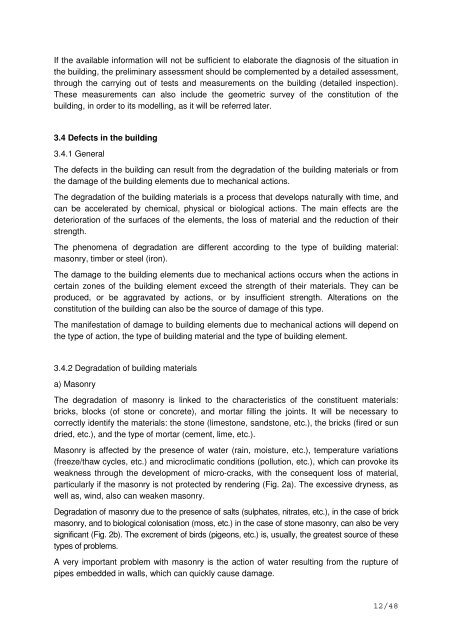Guide for the Structural Rehabilitation of Heritage ... - Test Input
Guide for the Structural Rehabilitation of Heritage ... - Test Input
Guide for the Structural Rehabilitation of Heritage ... - Test Input
Create successful ePaper yourself
Turn your PDF publications into a flip-book with our unique Google optimized e-Paper software.
If <strong>the</strong> available in<strong>for</strong>mation will not be sufficient to elaborate <strong>the</strong> diagnosis <strong>of</strong> <strong>the</strong> situation in<strong>the</strong> building, <strong>the</strong> preliminary assessment should be complemented by a detailed assessment,through <strong>the</strong> carrying out <strong>of</strong> tests and measurements on <strong>the</strong> building (detailed inspection).These measurements can also include <strong>the</strong> geometric survey <strong>of</strong> <strong>the</strong> constitution <strong>of</strong> <strong>the</strong>building, in order to its modelling, as it will be referred later.3.4 Defects in <strong>the</strong> building3.4.1 GeneralThe defects in <strong>the</strong> building can result from <strong>the</strong> degradation <strong>of</strong> <strong>the</strong> building materials or from<strong>the</strong> damage <strong>of</strong> <strong>the</strong> building elements due to mechanical actions.The degradation <strong>of</strong> <strong>the</strong> building materials is a process that develops naturally with time, andcan be accelerated by chemical, physical or biological actions. The main effects are <strong>the</strong>deterioration <strong>of</strong> <strong>the</strong> surfaces <strong>of</strong> <strong>the</strong> elements, <strong>the</strong> loss <strong>of</strong> material and <strong>the</strong> reduction <strong>of</strong> <strong>the</strong>irstrength.The phenomena <strong>of</strong> degradation are different according to <strong>the</strong> type <strong>of</strong> building material:masonry, timber or steel (iron).The damage to <strong>the</strong> building elements due to mechanical actions occurs when <strong>the</strong> actions incertain zones <strong>of</strong> <strong>the</strong> building element exceed <strong>the</strong> strength <strong>of</strong> <strong>the</strong>ir materials. They can beproduced, or be aggravated by actions, or by insufficient strength. Alterations on <strong>the</strong>constitution <strong>of</strong> <strong>the</strong> building can also be <strong>the</strong> source <strong>of</strong> damage <strong>of</strong> this type.The manifestation <strong>of</strong> damage to building elements due to mechanical actions will depend on<strong>the</strong> type <strong>of</strong> action, <strong>the</strong> type <strong>of</strong> building material and <strong>the</strong> type <strong>of</strong> building element.3.4.2 Degradation <strong>of</strong> building materialsa) MasonryThe degradation <strong>of</strong> masonry is linked to <strong>the</strong> characteristics <strong>of</strong> <strong>the</strong> constituent materials:bricks, blocks (<strong>of</strong> stone or concrete), and mortar filling <strong>the</strong> joints. It will be necessary tocorrectly identify <strong>the</strong> materials: <strong>the</strong> stone (limestone, sandstone, etc.), <strong>the</strong> bricks (fired or sundried, etc.), and <strong>the</strong> type <strong>of</strong> mortar (cement, lime, etc.).Masonry is affected by <strong>the</strong> presence <strong>of</strong> water (rain, moisture, etc.), temperature variations(freeze/thaw cycles, etc.) and microclimatic conditions (pollution, etc.), which can provoke itsweakness through <strong>the</strong> development <strong>of</strong> micro-cracks, with <strong>the</strong> consequent loss <strong>of</strong> material,particularly if <strong>the</strong> masonry is not protected by rendering (Fig. 2a). The excessive dryness, aswell as, wind, also can weaken masonry.Degradation <strong>of</strong> masonry due to <strong>the</strong> presence <strong>of</strong> salts (sulphates, nitrates, etc.), in <strong>the</strong> case <strong>of</strong> brickmasonry, and to biological colonisation (moss, etc.) in <strong>the</strong> case <strong>of</strong> stone masonry, can also be verysignificant (Fig. 2b). The excrement <strong>of</strong> birds (pigeons, etc.) is, usually, <strong>the</strong> greatest source <strong>of</strong> <strong>the</strong>setypes <strong>of</strong> problems.A very important problem with masonry is <strong>the</strong> action <strong>of</strong> water resulting from <strong>the</strong> rupture <strong>of</strong>pipes embedded in walls, which can quickly cause damage.12/48
















